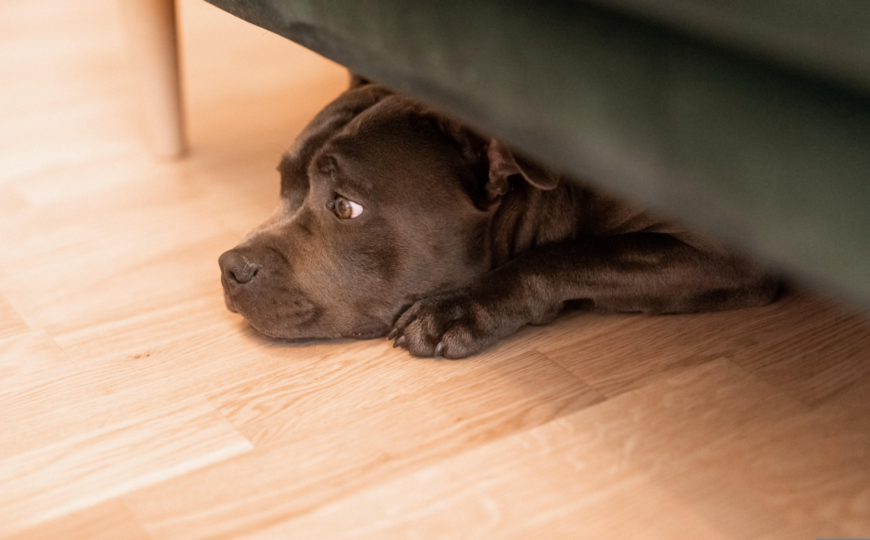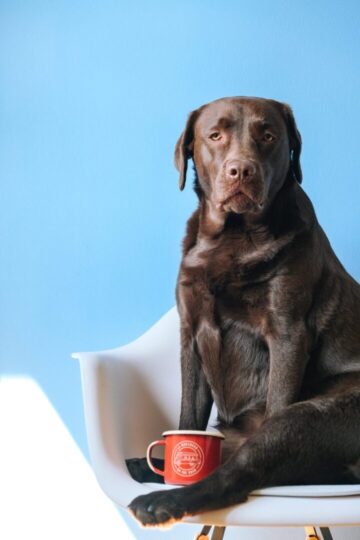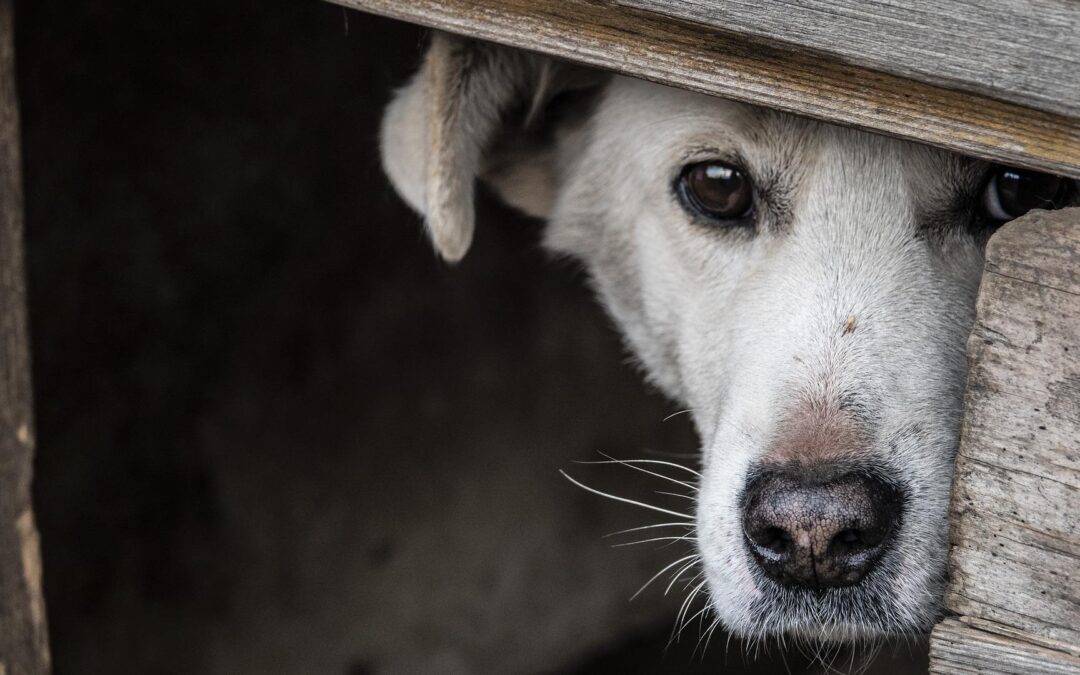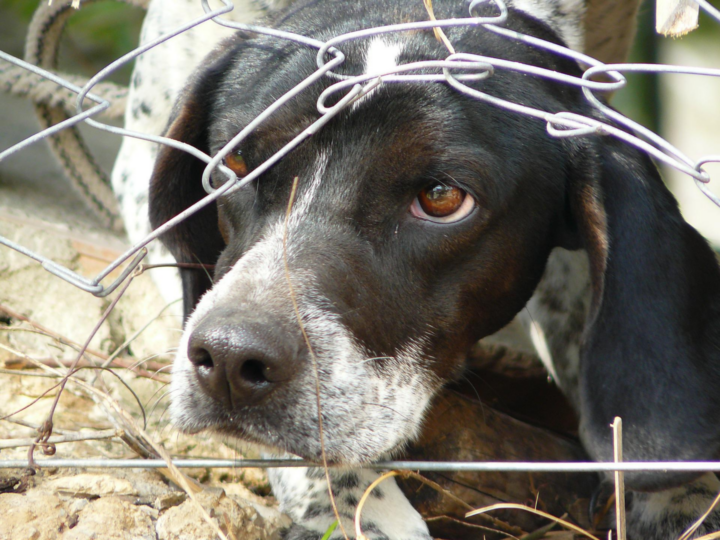Adopting a new dog is an exciting time. Becoming a pet parent may be something you’ve dreamt about or planned for a while. You bought the food, treats, and toys to pamper and spoil your pooch from the moment he joins your family. You’ve been excitedly counting down the days until his arrival.
But now that he’s here, you notice that the love and excitement you feel for him is not being returned. Maybe the cute and friendly dog you fell hard for at the breeder or dog shelter is now a scared dog who doesn’t seem interested in bonding with you at all. Or maybe you chose a rescue dog and they’re taking time to warm up to you. So what’s going on?

6 behaviors that might mean your dog is scared of you
1. Your dog is evasive with you.
A nervous dog may exhibit body language that is evasive. He may avoid eye contact with you, ignore you, or leave a room you are in simply to get distance from you.
2. Your fearful dog puts his back up.
If your dog raises up or rounds his back, this could be a sign that he feels threatened or scared. You may also notice the hair along his shoulders or back standing up, and this is also a sign of alarm in a dog.
3. He cowers or hides from you.
A fearful dog may hide or cower behind or under things. You may also notice that he trembles, tucks his tail between his legs, or lowers his ears back which are other signs that he feels fearful.
4. Your dog refuses snacks from you.
Most dogs love a snack, but if you toss a few treats to your dog that he doesn’t accept, that can be a sign that he is uncomfortable around you.
5. He growls at you or exhibits aggressive body language.
This is an obvious sign of a more aggressive dog, but if you find your dog is growling at you showing his teeth or biting, this is a tell-tale sign that he feels threatened. This more aggressive behavior is a sign that he feels the need to protect himself.
6. He exhibits other nervous behaviors.
Other signs a nervous dog may exhibit are lip licking or yawning even when he’s not tired.
So now that you know what the signs of a fearful dog are, you are probably wondering what is causing your new pet to be so uncomfortable.
Common causes of fear in dogs
Many of my clients often state that they believe that the cause of fear in their dog is the result of abuse; especially those who have rescue dogs or dogs that came from a shelter or other humane society. If I had a dollar for every dog I had been told had been abused, well I could retire from dog training. So if not abuse, what causes fear in so many dogs?
Fear is Actually a Helpful Part of Your Dog’s Biological Picture
If you step back and look at the bigger biological picture you can start to see how fear is actually a help to many dogs (although not to the owners dealing with these issues). Every creature abides by four primary biological needs: avoiding aversives, play, sex and food. These four items ensure the survival of our species at a very basic level. But the first on the list is not a mistake. Avoiding aversives is the number one way to ensure survival by any animal. We are all biologically programmed to stay away from things that might hurt us or cause us harm: including being afraid of things that go bump in the night.
A Scared Dog is Responding to Their Natural Survival Instinct
Fear plays a role at a very general level of supporting survival. If we are afraid of something and we stay away from it, move away from it or hide from it, well we are still here to tell the story and potentially get to one of the other biological imperatives we are all programmed with. The other side of the coin is if we are afraid of something and we attack it and it dies or goes away we have also protected ourselves from harm.
Fear Might Be a Natural Part of Your Dog’s Unique Personality
Picture kids and their personalities, there’s always one kid that will be the first to try something, the one that has no fear of the world. Then you have the shy, reserved child who needs coaxing to come out of their shell. Then there is the third kid who is a bully but secretly is just putting that image on for show as a way to protect themselves. I’m sure there are other versions of how to see kids. But I think that this is the simplest for our discussion purposes.
With dogs it’s really no different. You have the dog who even as a puppy is just like I’m here, you’re here and life is great! And will move towards anyone and anything with no sense of fear or panic. Then you have the dogs who are just shy and anxious almost from the moment they are born. The third is the category that I see the most though for training. These are the dogs that are fearful but act out in inappropriate ways because they feel they are protecting themselves from harm.
A Scared Dog May Not Have Been Exposed to Enough Experiences as a Puppy
Most of the time these fears arise because dogs who are not exposed to the world during crucial development periods. Most, not all, dogs will default to the fear mechanism to protect themselves from things they don’t understand. That new blender makes a noise I’ve never heard, so running away ensures that the dog is safe. Lunging at stranger walking by the crate and the stranger continues walking protects me.
As dogs develop it is critical that they be exposed to as many things as possible at as young an age as possible. When that doesn’t happen, backyard breeders, dogs from rural areas, dogs contained in a crate 20 + hours a day in a house or a barn with no interaction, that’s when you see the major fear issues. Of course there are those dogs that are just genetically more programmed to be fearful than others.
When a dog is fearful they can respond in one of four ways: acceptance, avoidance, fight or freeze. We would prefer a dog to just accept new things. That can just take some work and time to help show them that the world isn’t so terrible after all.
Recognize your dog in the above ? We can help
If what you just read applies to your dog we can help with those behaviors. Schedule a consult to talk about it.
Let’s put this in human terms.
Picture it:
You’re at work, getting on with your daily tasks, when your new supervisor marches in. You’re excited to meet them but before you can so much as put your hand out to greet them, they start barking a bunch of orders at you.“Wait a minute”, you think. “You’ve been here two seconds, we haven’t even been properly introduced, and you’re already telling me how to do my job?”
You’re equal parts pissed and confused at why they think you need to change how you work. And you sure as shit don’t feel inclined to jump to attention and comply with their requests.
Luckily, this isn’t a particularly common scenario. Sure, there are plenty of bad bosses out there but most of us inherently understand that there are processes we have to go through before we can instigate change in the workplace. We know the importance of getting to know people, of assessing our new colleagues’ strengths and weaknesses, of earning their trust.

Yet, we rarely apply the same principles to how we interact with our dogs.
Typically, when people approach dog training, they take a top-down approach — they’re the boss and it’s their job to issue the orders while it’s the dog’s job to comply without question; they plan to do X and expect their dog to do Y.
Then, when their dog acts in much the same way as the startled employee that can’t figure out what the hell’s happening, they get frustrated, they give up on training or worse, they give up on their dog.
If that sounds oh-so-familiar (and no judgment if it does — this is an extremely common dog approach taken by many trainers and their clients), I’m going to invite you to reframe the training relationship.
The key to building a strong bond with your dog: Remember that it’s a relationship.
Much like the relationship you cultivate with the people you work with, the training relationship you have with your dog should be a two-way street.
You can’t suddenly turn all Sergeant Major and expect full compliance; you have to take the time to earn your pup’s trust and their respect before they’ll consistently respond to your requests.
And if you’re dealing with an aggressive or fearful dog who may have been abused or neglected, you will have more work to do to get your dog to trust you and build a strong bond.
This is a relationship of equals.
You have to abandon the typical transactional, order-based framework of traditional training (that generally leads to behavior management rather than behavior change) and build a deeper foundation.
You have to provide your dog with the tools they need to think for themselves. You have to provide them with the tools they need to make great decisions not just when you’re reminding them not to pee in the house or chew up the couch but consistently so that they behave in the way you want when you’re in another room, when you’re not home, even when they’re boarding with your friends when you go on vacation.

Expect more from your dog.
The relationship of equals is a two-way street, and many of us instinctively give so much freely to our dogs without asking much from them in return. Because we love them so damn much we overlook behavior we’re not so keen on, we treat them like infants that don’t know any better, and we underestimate just how intelligent they are.
Yet if it were a human relationship, we’d expect more. Returning to our workplace analogy, as a new supervisor, we’d take time to evaluate our colleagues, we’d expect them to earn our trust. We’d understand the need to create healthy boundaries, and set realistic expectations. In doing so, we’d create stronger, mutually-beneficial relationships — and it’s the same with our furry friends.
Building a stronger relationship with your dog is a complex process. You can simplify it by creating a solid foundation of trust and respect — and by understanding that it should always — ALWAYS — be a relationship of equals. So as you think about your current relationship with your dog, don’t just think about whether they’ve earned your trust, consider whether you’ve earned theirs too.
So now that we know it’s about the relationship, what if your dog has additional emotional issues that need to be worked through in order to foster a strong bond between you? Maybe you’ve adopted a shelter dog that was neglected, or perhaps you have rescue dog that was abused.
Dogs who come from these types of background may display fearful, reactive or even aggressive behavior and gaining their trust can be a slow process. However, it’s in the best interest of you and your new dog to work through it together because the reward is well worth it. Below we’ll discuss steps you can take to bond with a fearful dog.
4 Steps to Get a Scared Dog to Trust You
- You = Food. Teach the dog that you have food and they can get it from you. This requires using their actual food and not treats as well as employing our perception modification techniques.
- Be Patient. They may need a slower speed to get comfortable.
- Be Consistent. ALWAYS. It is much easier for a fearful or aggressive dog to relax if they know and understand the outcomes and can predict them. Check out our article on Your Dog and the Power of Prediction
- Communicate. Educate your dog about the world around them. Name things as you expose them to it. Give them the information to be able to make better decisions.
Need some help earning trust?
How long does it take for a fearful dog to trust you?
I wish there was a firm answer to give on this one. It will take as long as is necessary for the dog to feel comfortable and confident with you. Most, or some, dogs it may take as little as an hour. Other dogs it could take several days or more. It’s how we handle these situations and react to them that makes the most difference. Don’t take it personally if the dog needs time and space. They are working through many emotions and it is best to just let these things go at their own pace.
How do you know if your dog is bonding with you?

5 Signs Your Dog Trusts You
- Your dog moves towards you more willingly and without coaxing.
- Your dog is less hesitant to explore the world around them.
- Your dog engages in play with you.
- Your dog is not on alert every time you stand up or move.
- Your dog offers more calming and relaxing signals (full body shake, sighs, relaxed face)
If your new pup displays fearful or anxious behavior to the point that you’re not forming the close and loving relationship you had hoped to, the tips mentioned above are good initial steps to take towards helping your scared dog trust you.
In cases where a dog has deeper emotional issues stemming from abuse or neglect, or if you are not seeing improvement with your efforts, you should talk to a professional dog trainer or behaviorist who is experienced working with fearful or traumatized dogs. If you’re a dog owner in the Washington, DC, Northern Virginia or Maryland area, I’d love to help.


